Beyond Mums and Pumpkins: Fall Window Boxes that are Unique
A November morning. Frost crystals catch light on pewter-toned grasses. Copper tape collars reflect dawn onto trailing strawberries. And no, you’re not looking at your grandmother’s fall window box.
Gone are the predictable orange mums. The mini pumpkins gathering dust. The same tired combinations we’ve seen for decades.
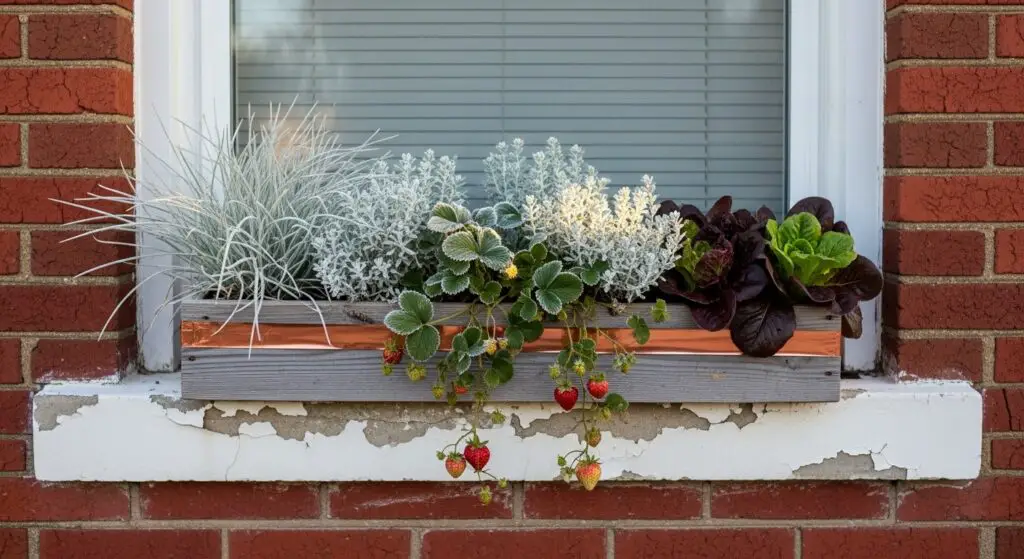
What if your fall window box could be a micro-ecosystem? A harvest garden? A design statement that evolves through three seasons?
Most gardeners think fall means shutting down. Pulling out summer flowers. Stuffing in some chrysanthemums. Calling it done. But fall offers something summer can’t—dramatic temperature swings that intensify colors, morning frost that creates natural art, and plants that actually prefer cool weather.
Your window box can feed birds through migration. It can flavor your dinner with fresh herbs into December. It can glow softly after dark when you need light most.
We’re moving beyond orange-and-rust clichés. Beyond static displays that look good for two weeks. You’ll create living art that changes daily, serves multiple purposes, and costs less than those overpriced mum-and-pumpkin combos at the garden center.
Ready to transform that rectangle of possibility outside your window?
The New Philosophy of Fall Window Design
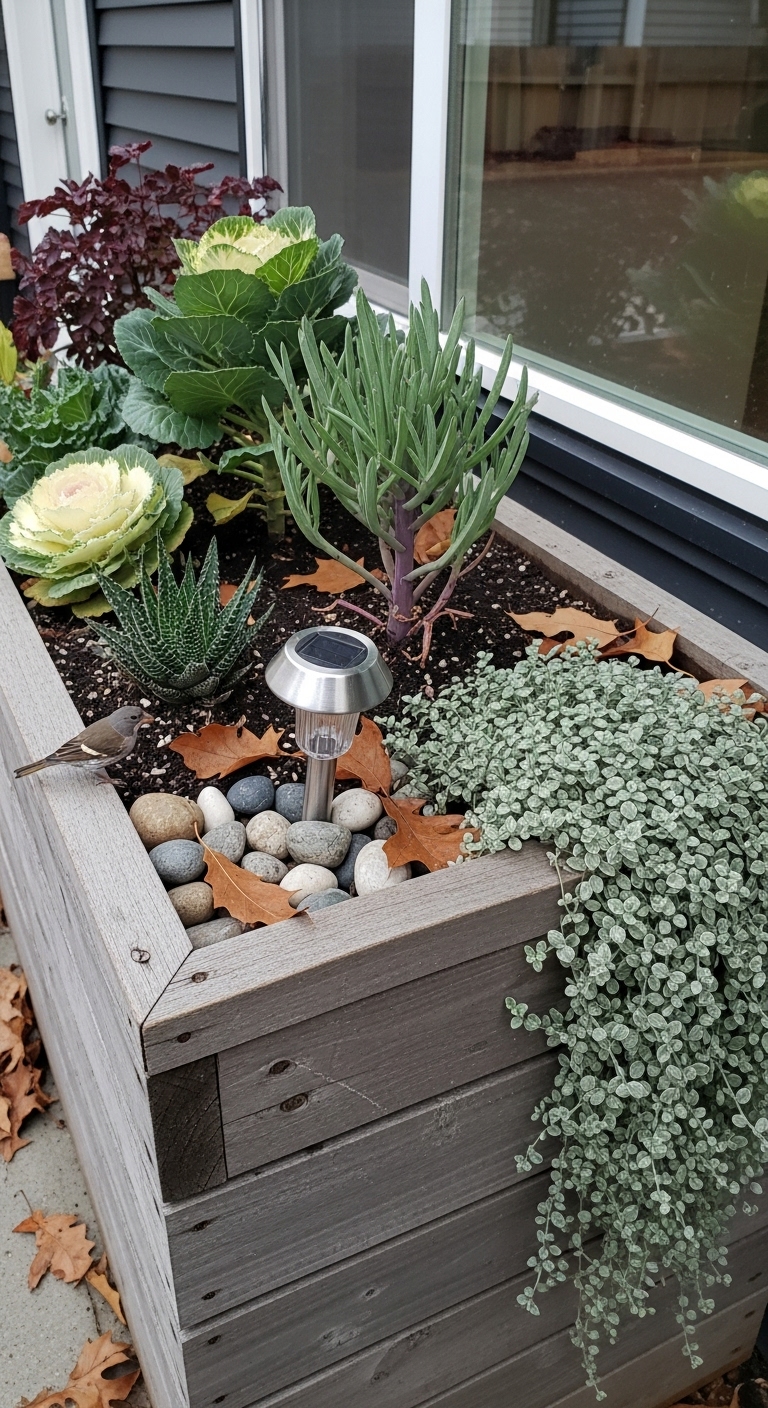
Window boxes aren’t decorations anymore. They’re dynamic ecosystems. Living, breathing extensions of your home that work harder than any indoor houseplant.
The old way? Buy mums. Add mini pumpkins. Water occasionally. Watch everything die by Thanksgiving. Start over next year.
The new way builds on three pillars:
Climate intelligence means working with your specific conditions. Not fighting them. Your north-facing window in Chicago needs different plants than a south-facing box in Atlanta. Obvious? Sure. But most gardeners ignore it.
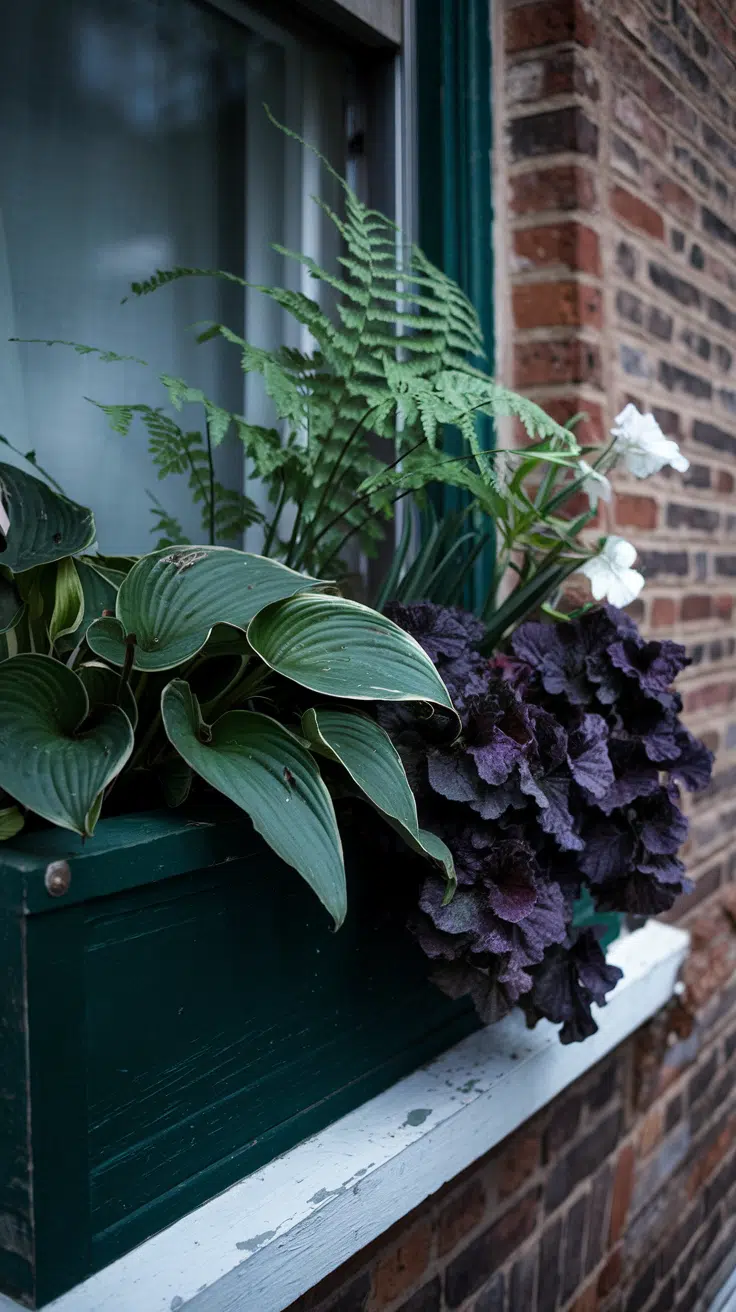
Sensory layering goes beyond visual appeal. Touch matters—soft lamb’s ear next to spiky sedge. Scent matters—lemon thyme releasing fragrance when you open the window. Sound matters—ornamental grasses rustling in wind.
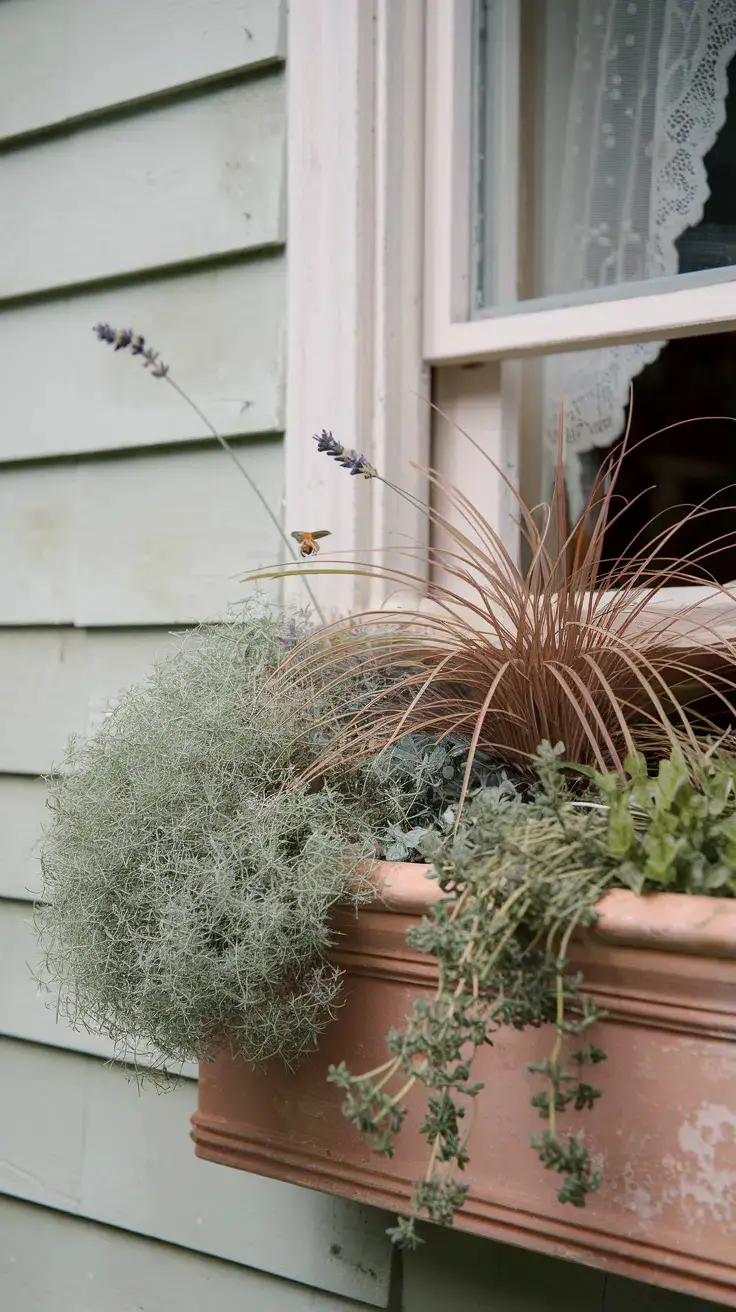
Sustainable beauty keeps your box thriving with minimal input. Choose plants that don’t need constant watering. Use materials that improve each season. Design for evolution, not perfection.
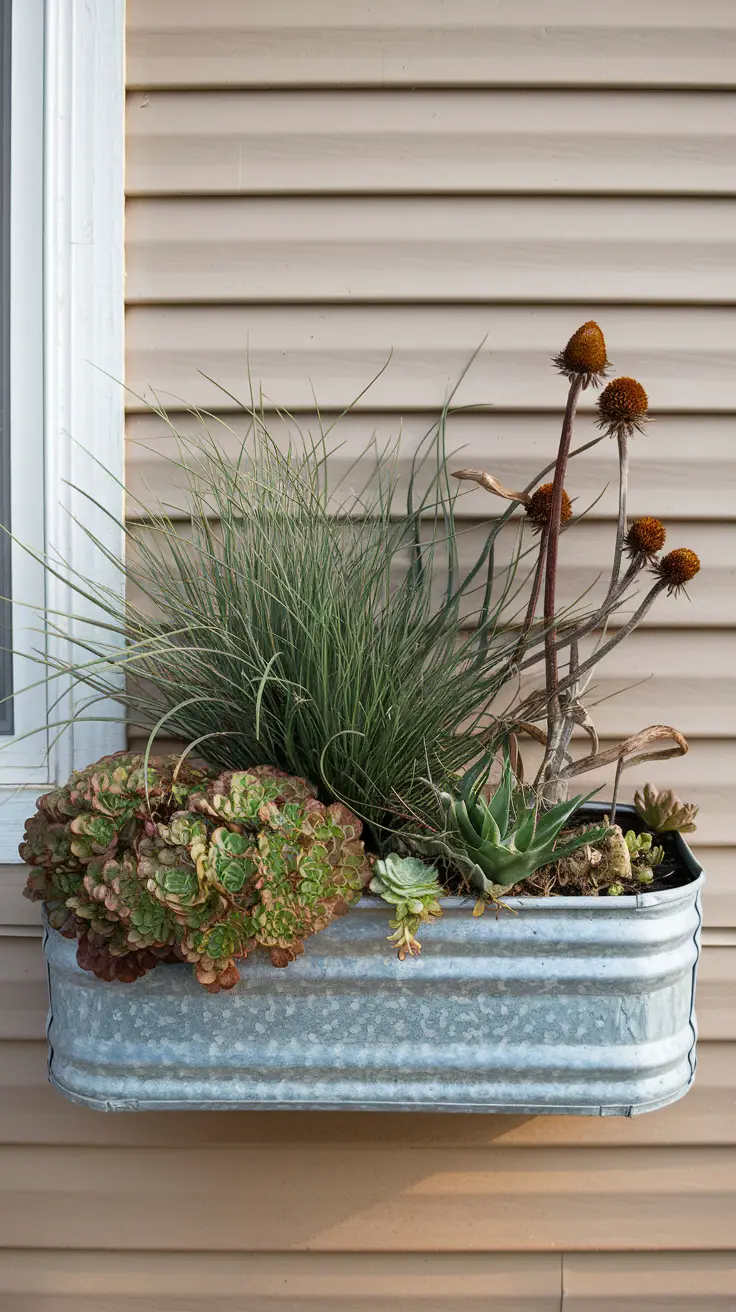
Why do fall window boxes fail? Three reasons.
First, people choose plants for how they look at the garden center. Not how they’ll perform in their specific spot. That perfect mum wilts in full sun. Those pansies freeze in exposed locations.
Second, they create static displays. Like flower arrangements that happen to be alive. No consideration for growth patterns. No planning for weather changes. No backup plan when something dies.
Third, they follow trends blindly. Everyone’s doing succulents? Must do succulents. Even if you live in rainy Seattle.
Our approach prevents these failures. You’ll analyze your exact conditions. Select plants that thrive there naturally. Build in flexibility for weather surprises. And create something uniquely yours—not a Pinterest copy.
Know Your Window: Micro-Climate Mapping
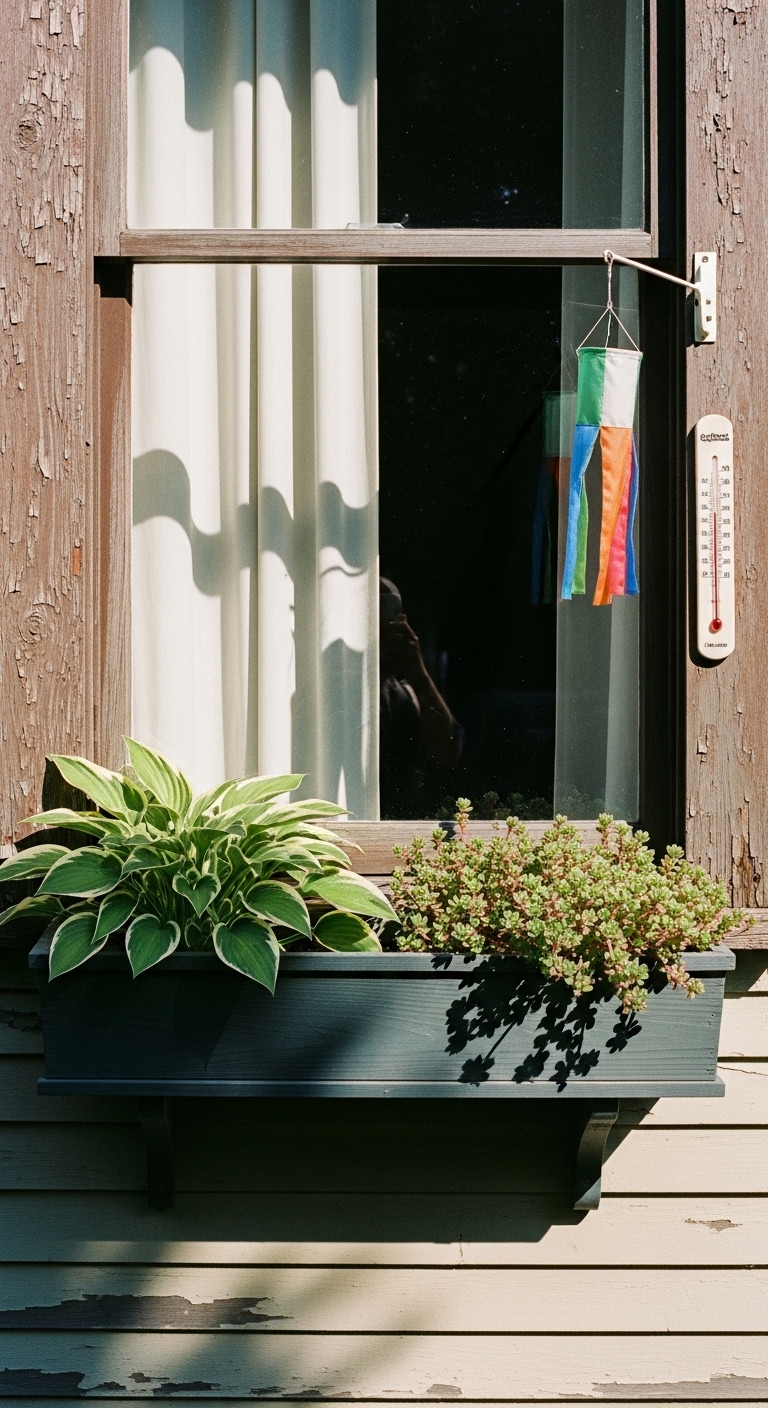
Skip this step and everything else fails. Your window has its own micro-climate. Different from your neighbor’s. Different from your backyard. Sometimes different from the window six feet away.
Start with sun tracking. Not a casual “it gets morning sun” observation. Real data.
Set a timer for every hour from 7 AM to 6 PM. Each hour, check your window. Full sun? Partial shade? Deep shadow? Mark it down. Do this for three days—one cloudy, one sunny, one mixed.
You’ll discover surprises. That “full sun” window might get blasted from 2-4 PM only. The “shady” spot might receive reflected light from windows across the street. These details determine everything.
Next, assess wind patterns. Windows create tunnels. Air accelerates between buildings. Corner locations get hammered from two directions.
Hold a ribbon at your window box location. Watch how it moves throughout the day. Gentle flutter? Constant whipping? Dead calm? Each needs different plant choices.
Don’t forget heat reflection. White siding bounces light and heat. Dark brick absorbs and radiates warmth hours after sunset. Glass buildings create intense hot spots. Metal awnings provide cool shade but drip condensation.
Here’s your Window Audit Worksheet:
Sun exposure log: Hour-by-hour tracking grid
Wind assessment: Direction, intensity, frequency
Temperature variations: Morning vs. afternoon readings
Reflected heat sources: Nearby surfaces and their effects
Water exposure: Rain protection, runoff patterns
Existing challenges: Previous plant failures and why
Let’s see real examples.
North-facing city window: Gets two hours of reflected morning light. Constant wind from street canyon effect. Protected from rain by fire escape above. Solution: tough, shade-tolerant plants like Japanese painted ferns, coral bells, and trailing vinca. Add weight to prevent tipping.
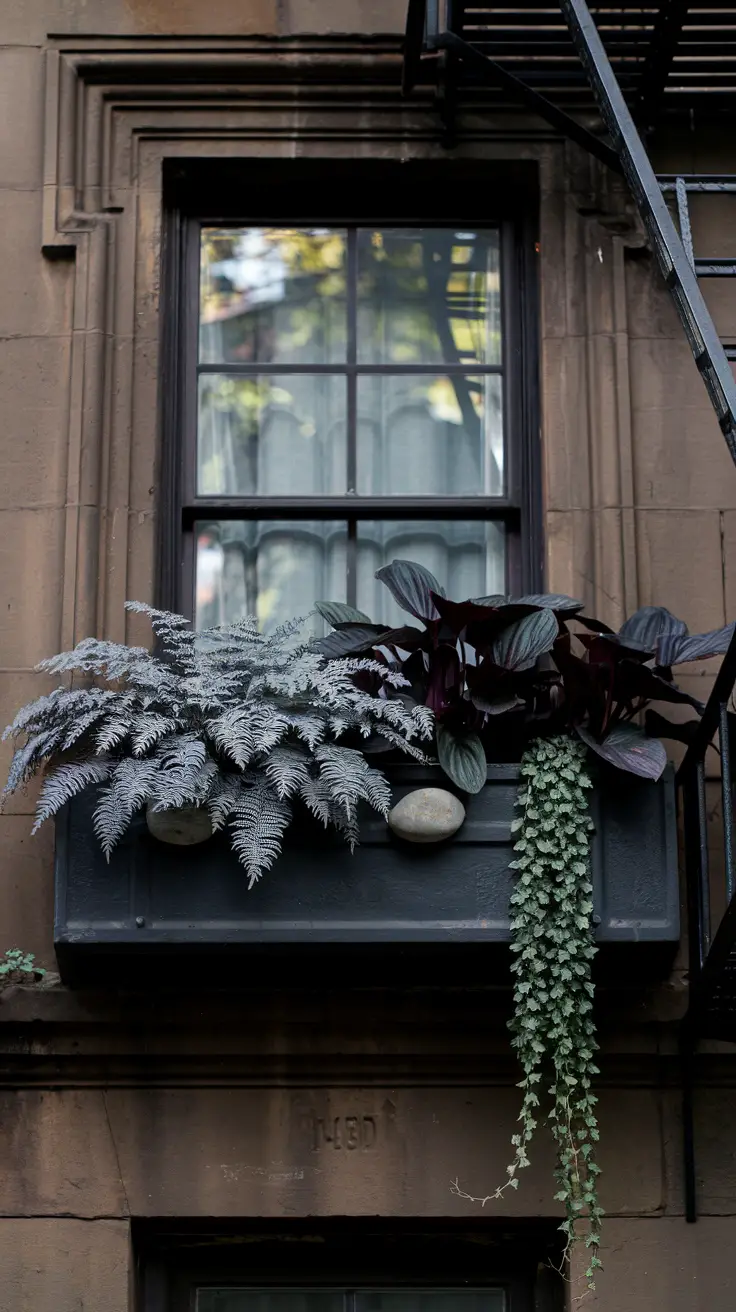
South-facing suburban sill: Full sun from 10 AM to 5 PM. Minimal wind. Exposed to rain. Gets additional heat from concrete driveway below. Solution: drought-resistant selections like lavender, ornamental oregano, and silver sage. Deep mulch for moisture retention.
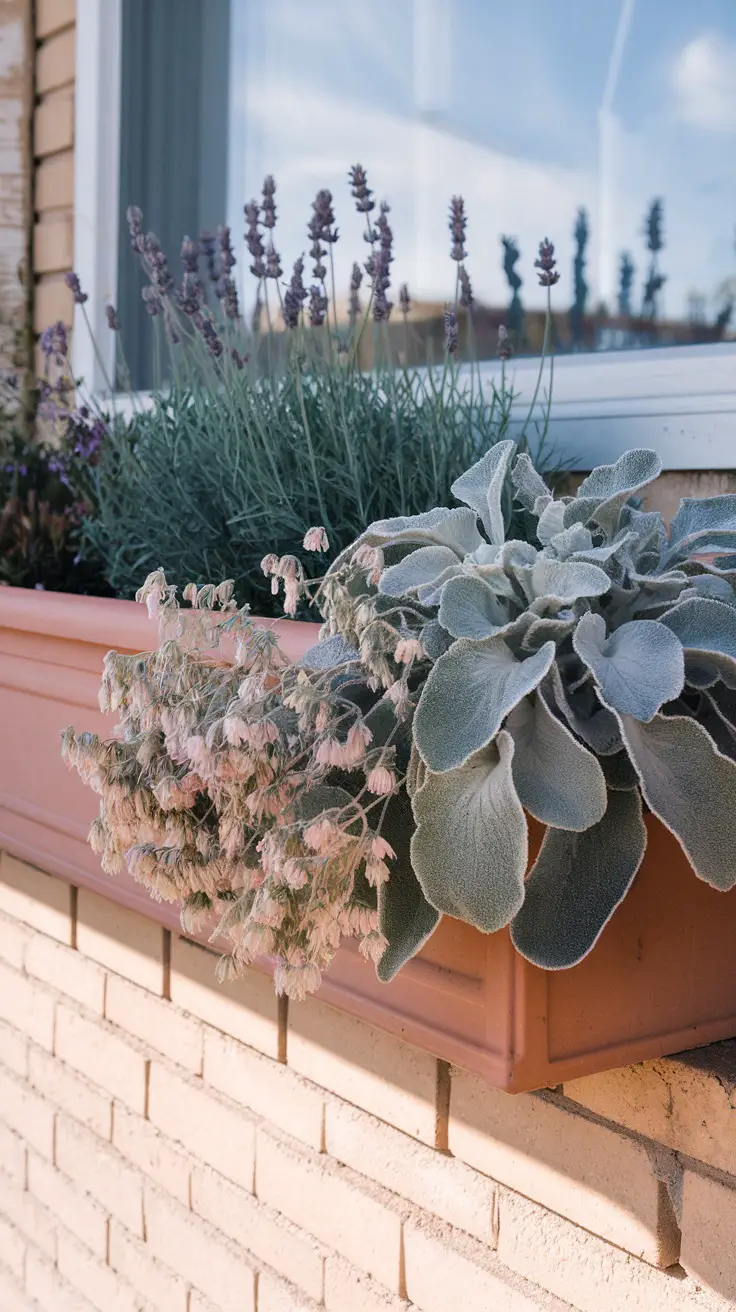
Your window is unique. Treat it that way.
Color Revolution: Palettes Beyond Autumn Clichés
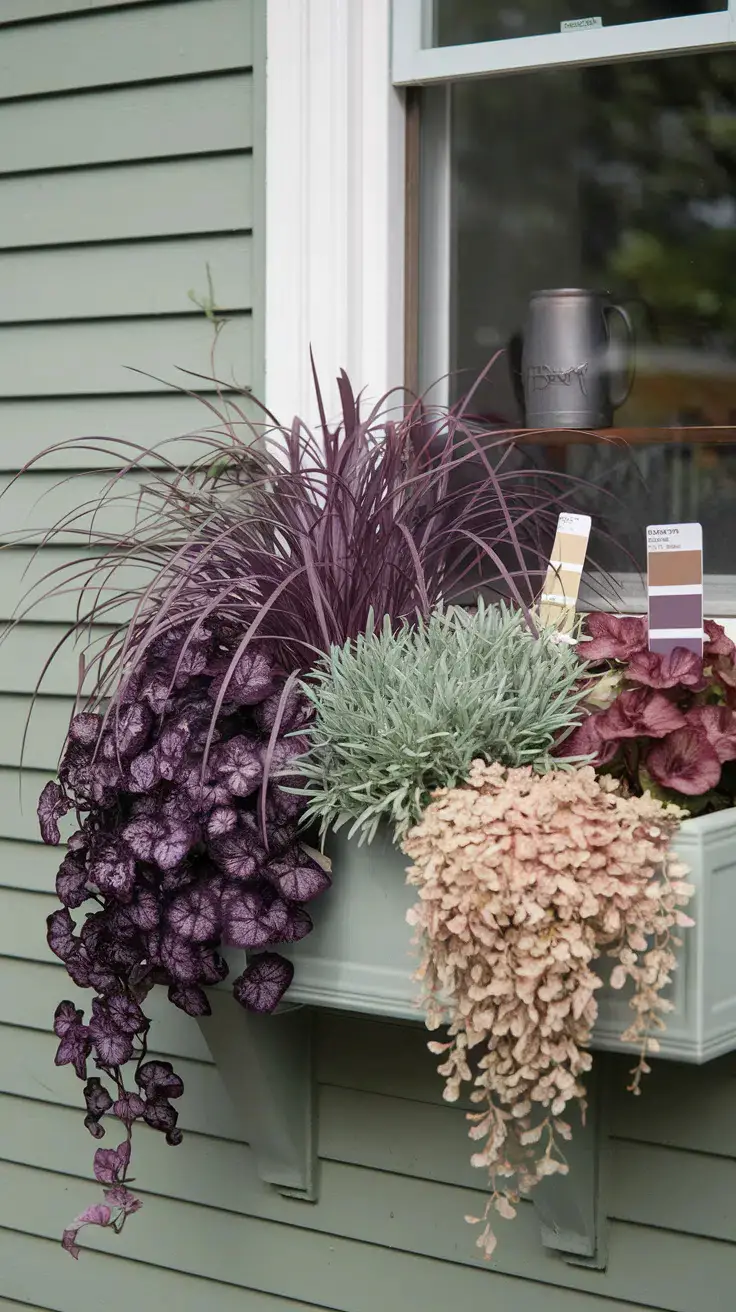
Rust and mustard? They’re tired. Predictable. Like wearing the same outfit to every party.
Interior designers abandoned autumn clichés years ago. Time for gardeners to catch up. Your window box should complement your home—not scream “October” at every passerby.
Try these unexpected color triads:
Pewter + blush + chocolate creates sophistication. Think silver-leafed artemisia, pale pink diascia, and bronze fennel. Soft but striking. Works with gray, white, or cream houses.
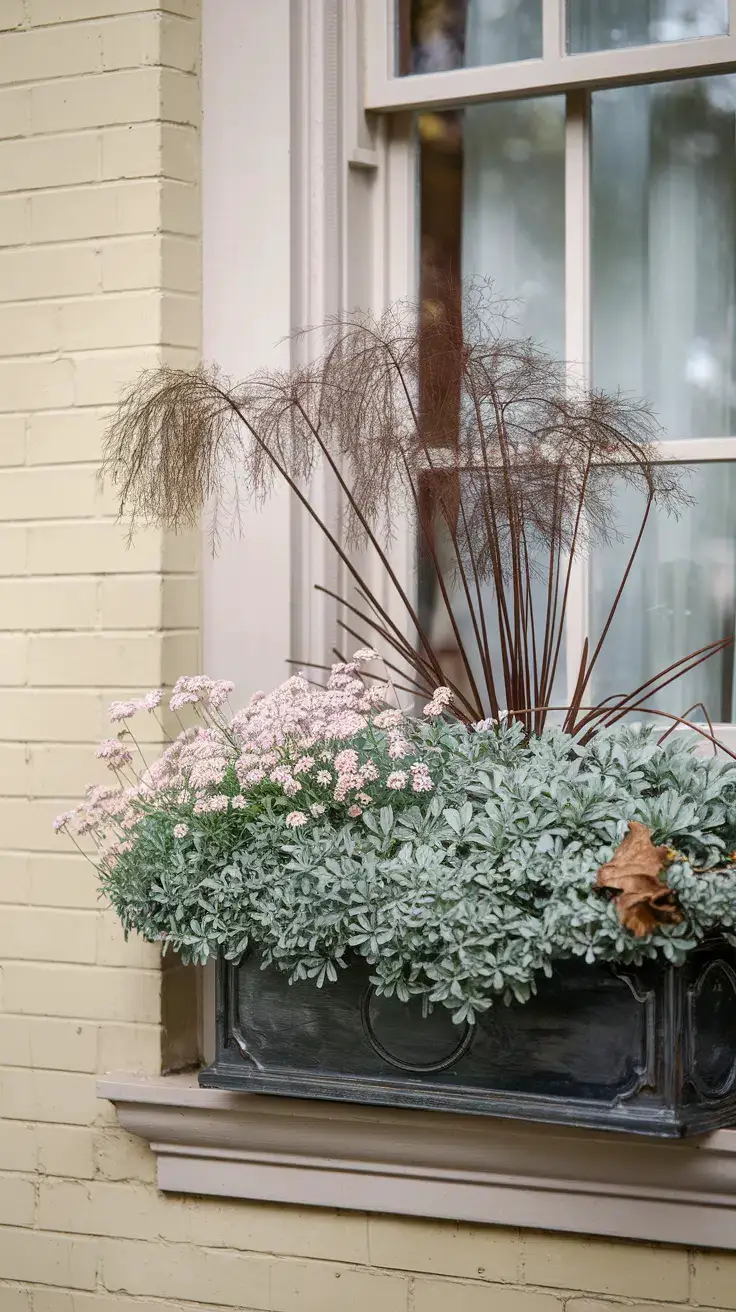
Celadon + copper + midnight violet brings drama without harshness. Combine sage-green santolina, copper-leafed alternanthera, and deep purple petunias. Perfect against brick or natural wood.
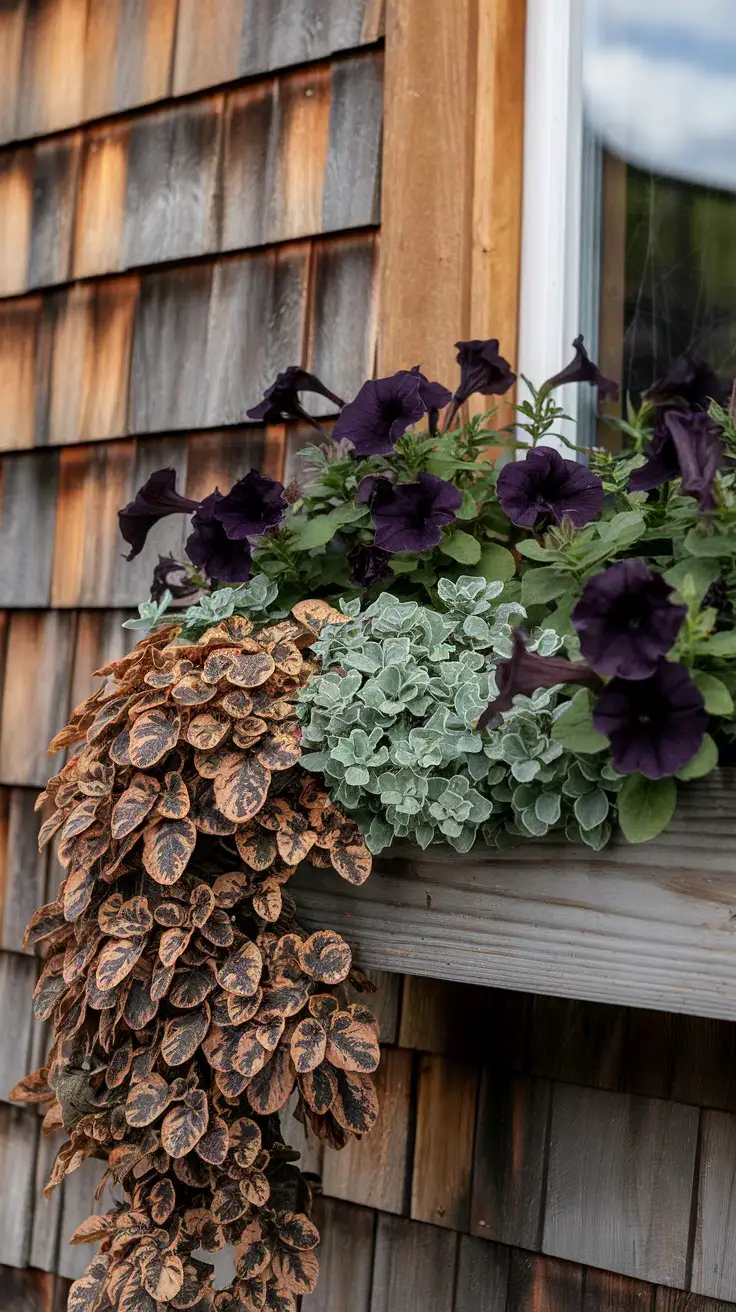
Sage + burgundy + champagne whispers elegance. Mix gray-green lavender, burgundy lettuce, and cream-colored ornamental kale. Stunning with any house color.
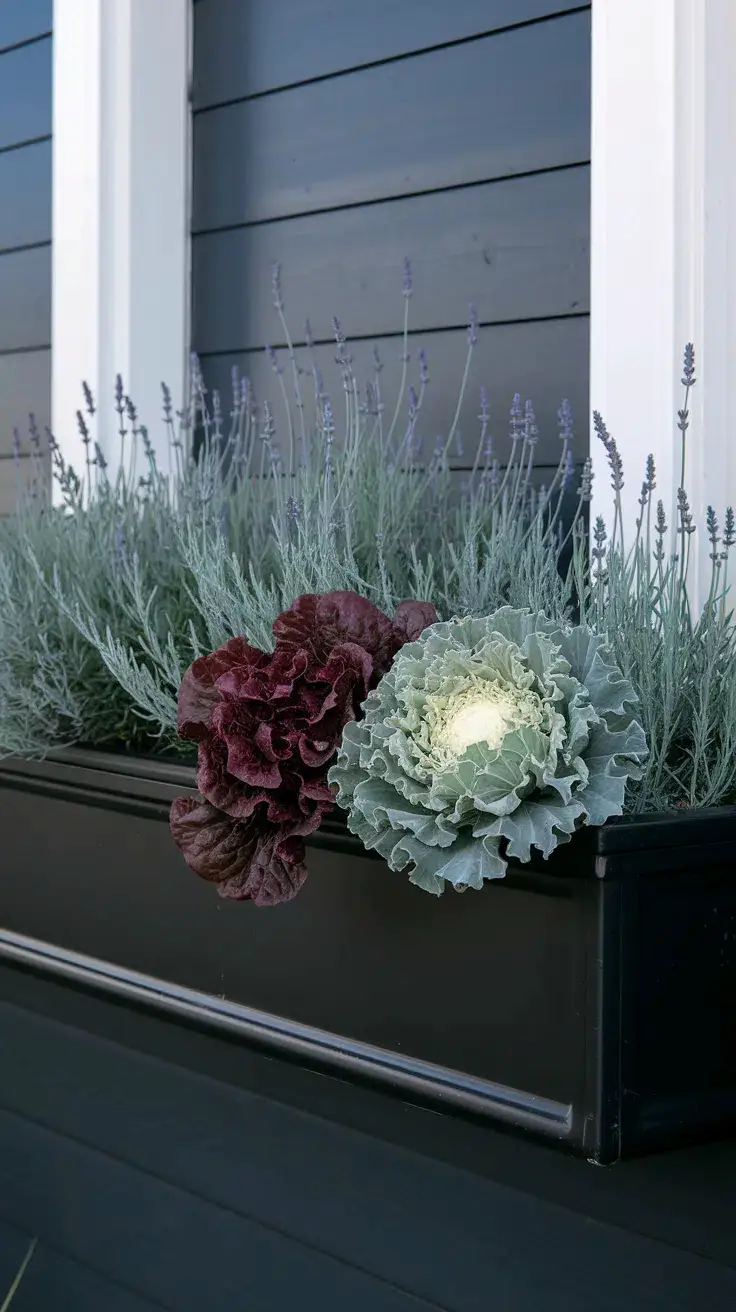
But how do you plan these combinations?
Visit the paint department. Grab chip samples in your chosen palette. Free color guides that fit in your pocket. Take them plant shopping. Hold chips next to potential plants. Match or complement—your choice.
Look at your house objectively. What color is the siding? The trim? The door? Your window box shouldn’t fight these elements. It should enhance them.
Navy house with white trim? Try silver, white, and deep purple. Tan stucco? Go for terracotta, sage, and cream. Red brick? Pewter, burgundy, and chartreuse pop beautifully.
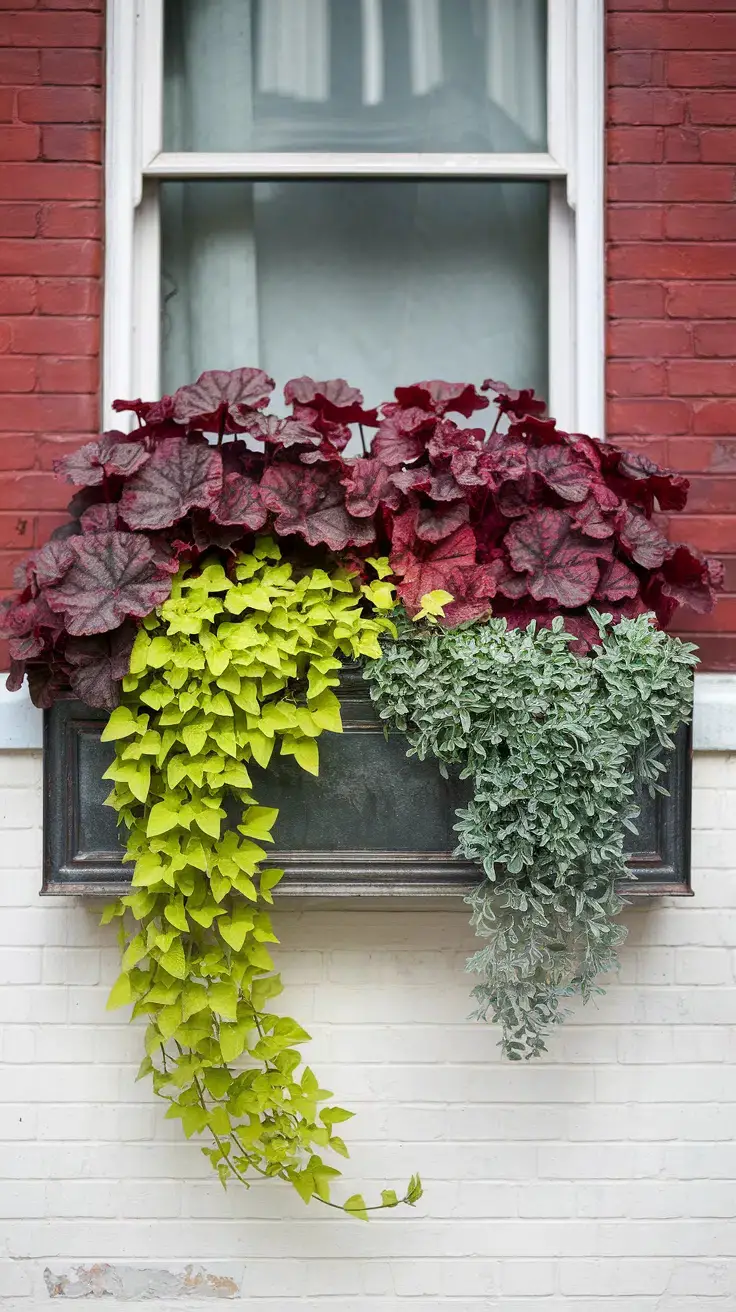
Consider your interior too. People forget—you see window boxes from inside most often. That burgundy and copper combo looks different against your yellow kitchen walls than it does from the street.
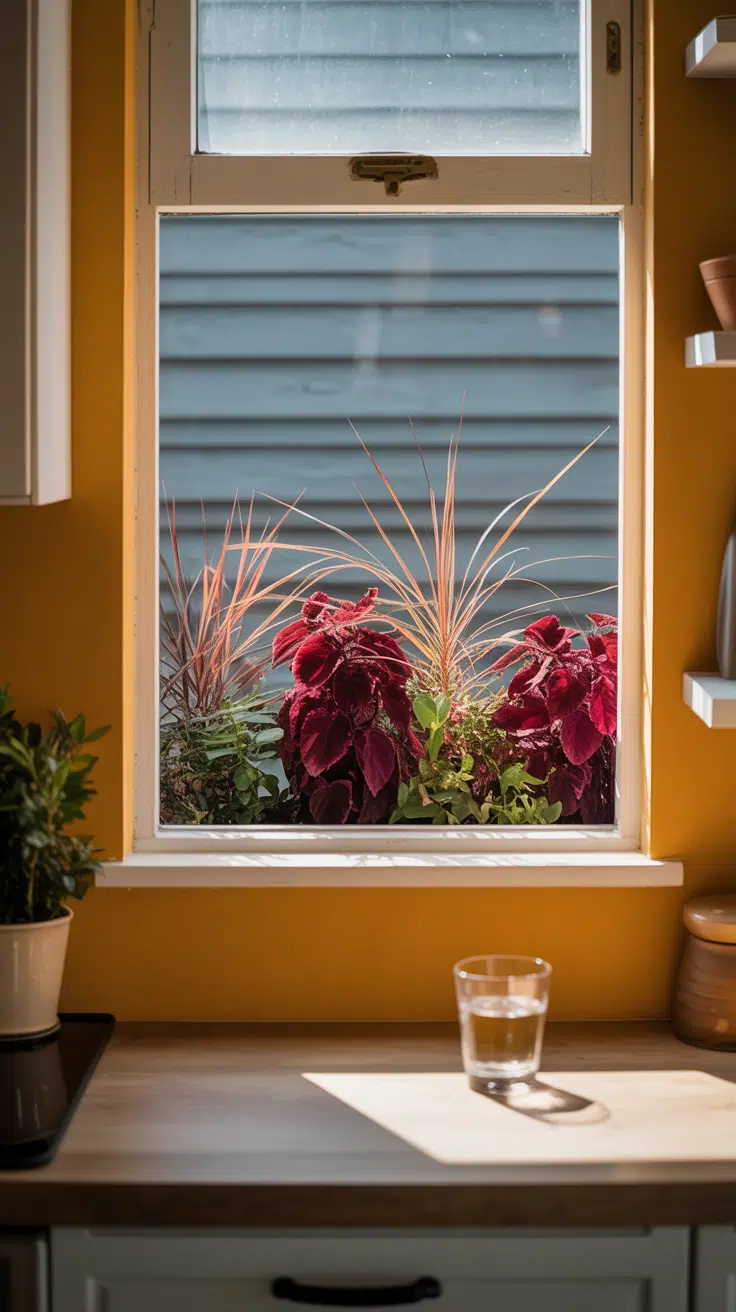
Test combinations before committing. Buy one plant from each color group. Arrange them at your window. Live with them for a day. Morning light changes everything. So does evening shadow.
And remember—green counts as a color. Not all greens work together. Blue-green hostas clash with yellow-green coleus. Silver-green sage complements both. Pay attention.
Your window box is art. Make it yours.
Texture First, Flowers Second
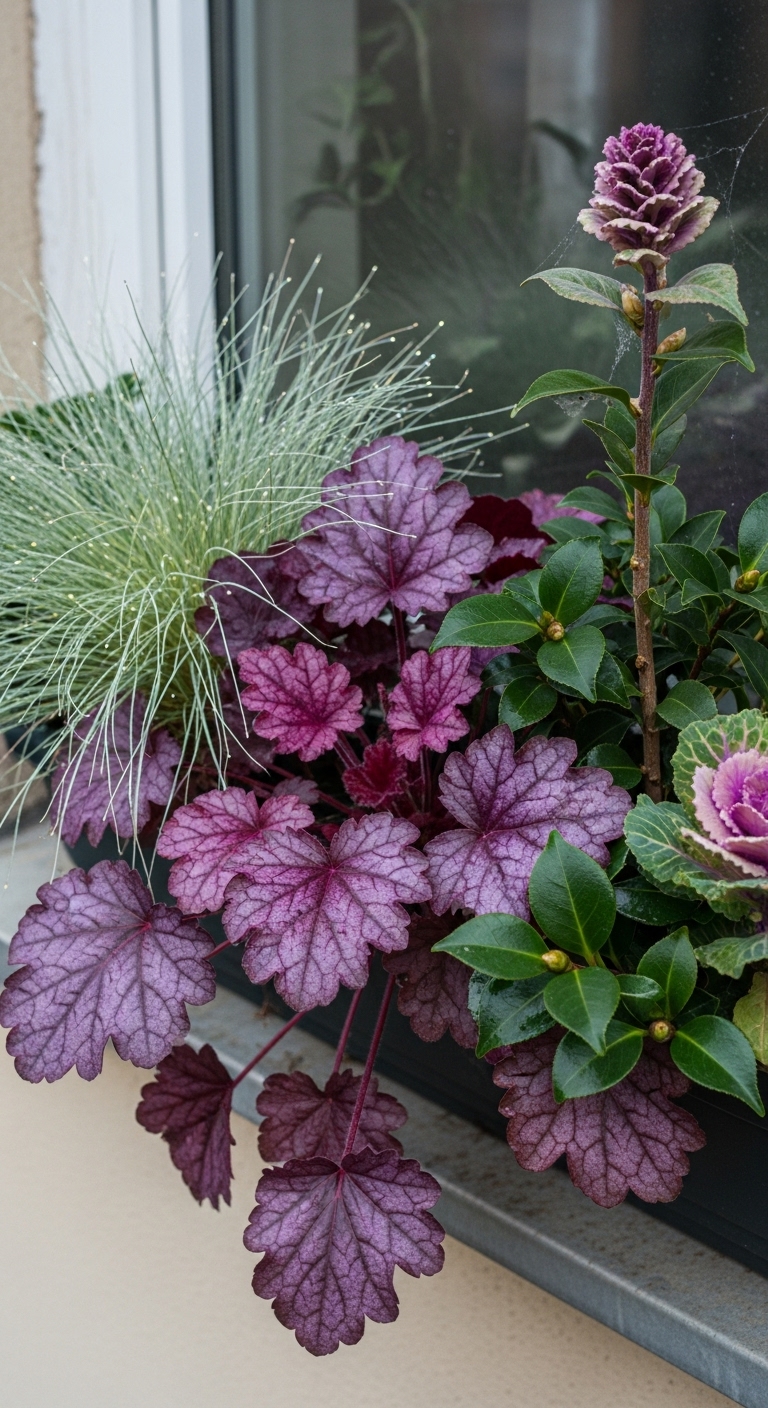
Forget flower obsession. Texture creates year-round drama. Flowers come and go. Foliage stays.
Four texture categories transform ordinary boxes into extraordinary displays:
Matte textures absorb light. They create depth and shadow. Heuchera leads this category—’Plum Pudding’ for purple tones, ‘Lime Marmalade’ for chartreuse. Lamb’s ear adds silver softness. These plants make glossy neighbors pop.
Glossy textures reflect and shine. Dwarf camellia sasanqua brings evergreen glamour. ‘Yuletide’ blooms red in December. Bergenia leaves turn bronze with cold. European ginger stays mirror-bright all winter. Place these where they’ll catch light.
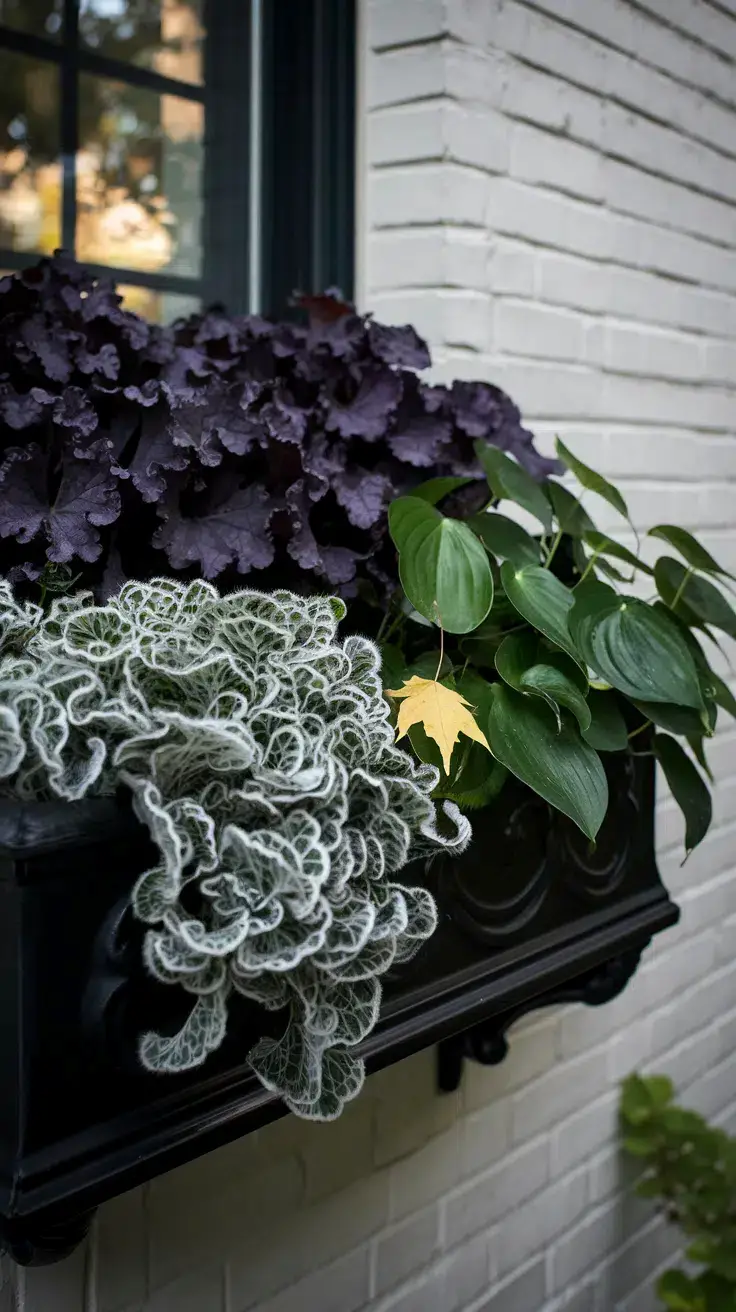
Wispy textures add movement. Fiber optic grass dances in the slightest breeze. Carex ‘Evergold’ fountains yellow and green. Mexican feather grass creates soft clouds. But check hardiness—some grasses won’t survive your winter.
Sculptural textures provide structure. Ornamental cabbage on tall stems looks like purple roses. Architectural succulents—think ‘Sticks on Fire’ or blue chalk sticks—create living sculptures. Twisted willow branches add winter interest.
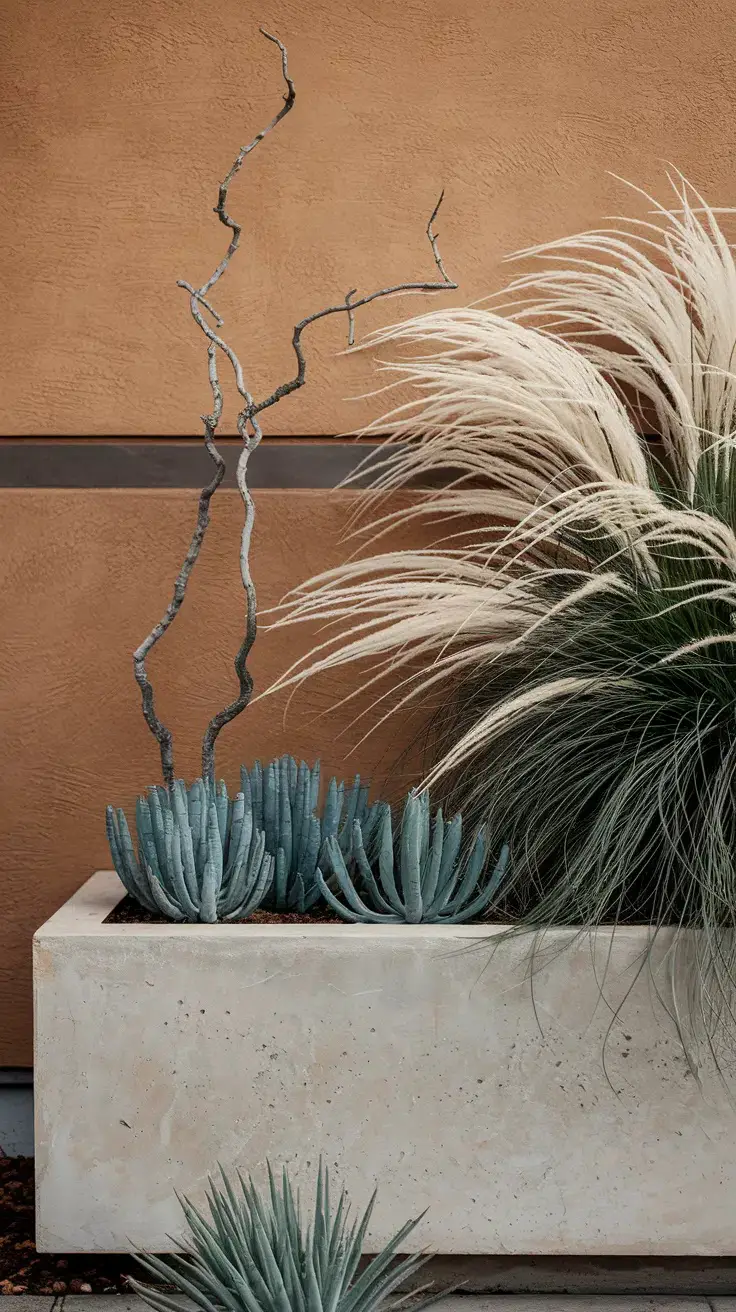
Here’s the Nursery Touch Test: Thick, firm leaves usually mean better cold tolerance. Paper-thin leaves spell trouble. Waxy coatings protect against frost. Fuzzy surfaces trap insulating air. Touch tells you more than labels.
Combining textures needs restraint. Too many compete for attention. Try this formula: one matte base plant (takes up 40%), one glossy accent (30%), one wispy spiller (20%), one sculptural statement (10%).
Real example: Purple heuchera base, glossy winter berry stems, trailing silver dichondra, single ornamental kale on stem. Simple. Effective. Stunning.
Maintenance varies by texture. Matte plants often need less water—their leaves reduce evaporation. Glossy leaves show water spots—use drip irrigation. Wispy grasses need spring haircuts. Sculptural plants require occasional grooming.
Don’t overthink it. Start with two contrasting textures. Add more as you gain confidence. Your fingers learn what your eyes like.
The Edible Understory: Beauty Meets Function
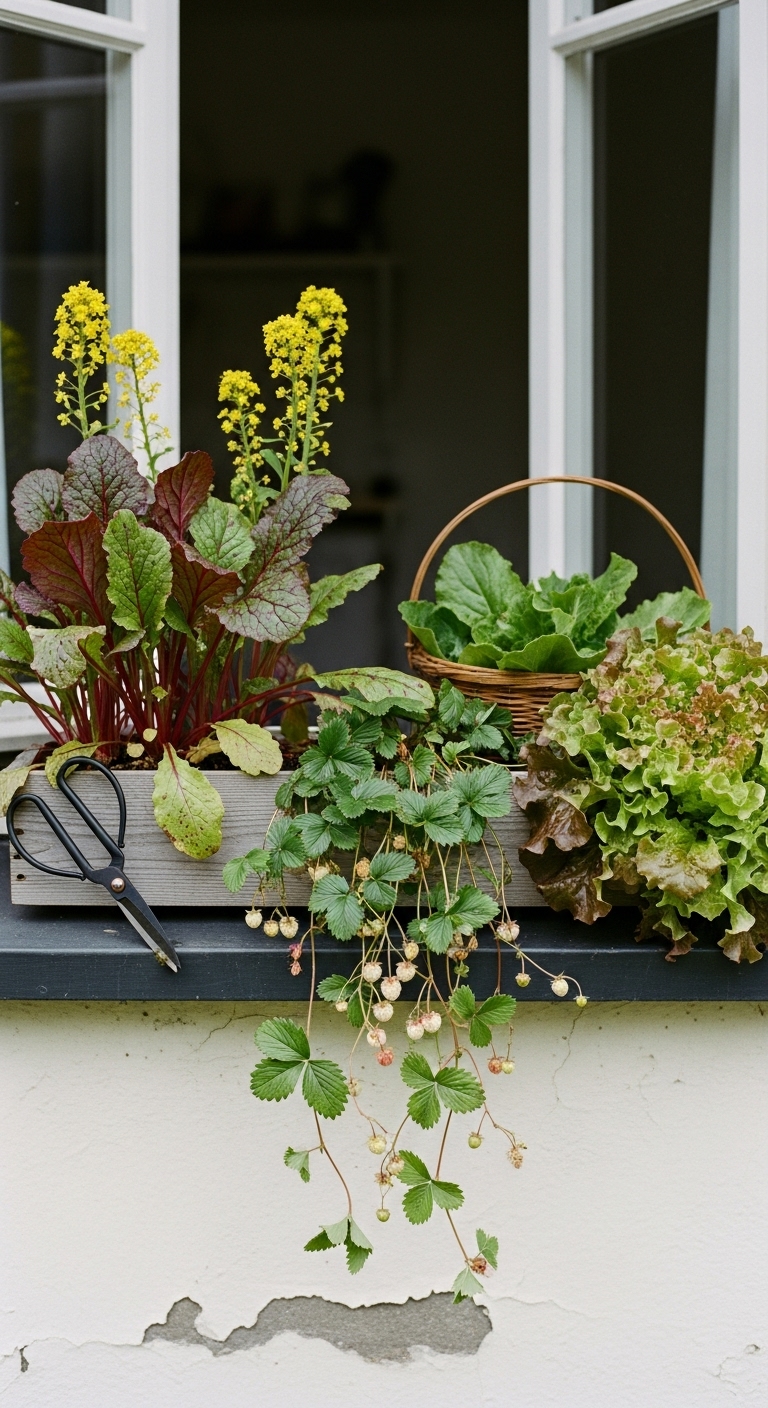
Your window box can feed you. Through November. Into December. Sometimes beyond.
Micro-greens and cool-season edibles thrive when summer crops surrender. They’re beautiful. They’re practical. And they’re easier than you think.
Top performers that look as good as they taste:
Ruby-streaked mustard brings purple-red veining on emerald leaves. Spicy flavor intensifies with cold. Cut leaves individually—plants keep producing. ‘Red Giant’ and ‘Osaka Purple’ lead for color.
Trailing strawberries offer year-round interest. Alpine varieties like ‘Mignonette’ produce tiny, intensely flavored berries into frost. White flowers appear randomly. Runners cascade romantically. Birds love them too.
Winter lettuce comes in architect-worthy forms. ‘Rouge d’Hiver’ develops bronze tones. ‘Winter Density’ forms perfect miniature romaine heads. ‘Arctic King’ laughs at freezing temperatures.
Placement strategies matter. Put cut-and-come-again crops like mustard greens at front. Easy access for quick snips. Trailing plants at corners—they’ll spill attractively. Heading lettuces in back—they need less frequent harvest.
Quick window box recipes:
Mustard Green Chips: Toss torn leaves with olive oil and salt. Bake at 350°F until crispy. Better than kale chips.
Strawberry Leaf Tea: Dry young leaves. Steep like regular tea. High in vitamin C.
Winter Lettuce Wraps: Use sturdy leaves instead of tortillas. Fill with warm grains and roasted vegetables.
Succession planting extends your harvest. Start new lettuce seeds every two weeks. Tuck seedlings between mature plants. As you harvest outer leaves, babies fill gaps.
Balance aesthetics with productivity. Alternate colors—green lettuce, purple mustard, green lettuce. Use edibles as borders. Let some plants flower for beauty. Mustard blooms bright yellow. Arugula flowers taste peppery.
One window box can provide daily salads for one person. Weekly garnishes for a family. Plus the satisfaction of December harvests while neighbors’ gardens sleep.
After Dark: Nighttime Glow Strategies
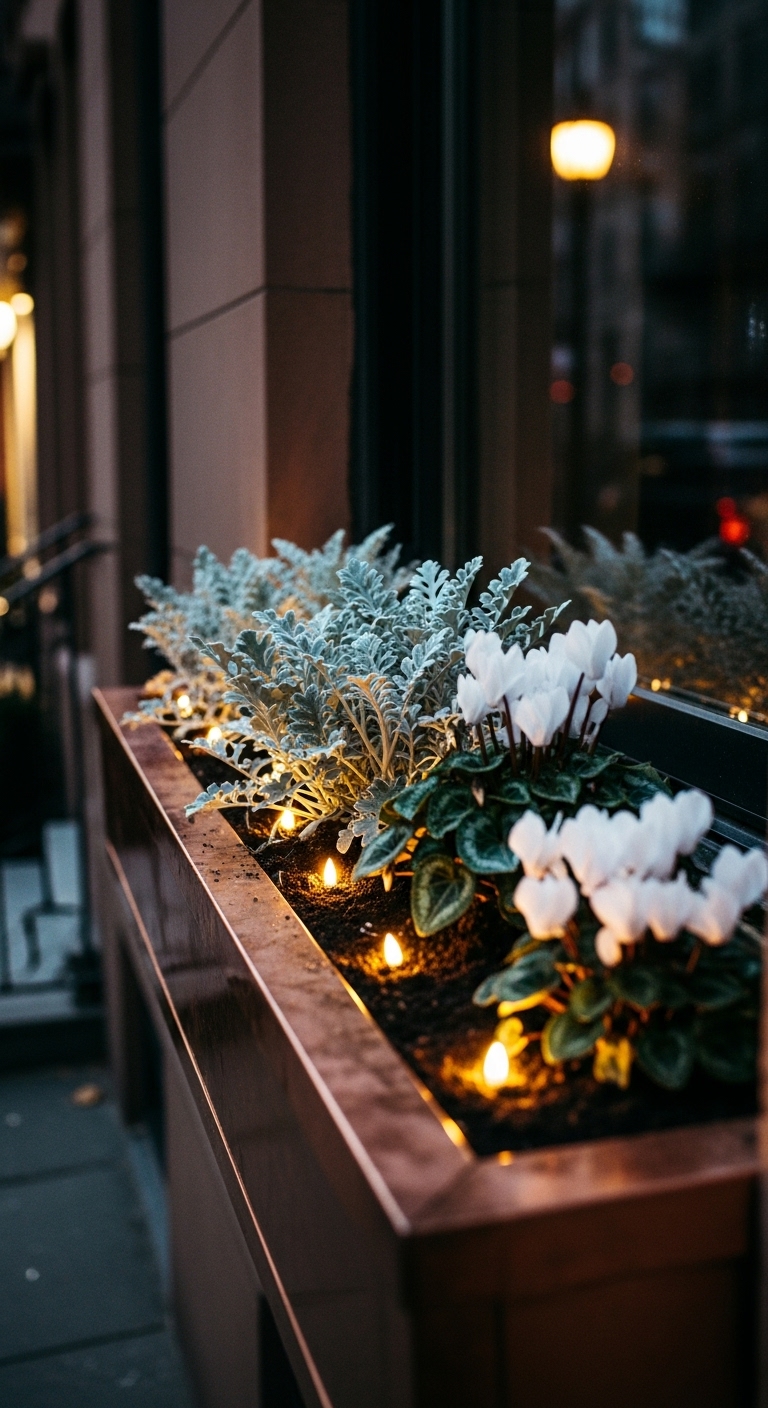
Fall means darkness at 5 PM. Your window box shouldn’t disappear. Subtle illumination extends enjoyment hours past sunset.
Forget string lights draped on top. Too obvious. Too Christmas-y. Think understated magic instead.
Low-voltage fairy lights work best buried at soil level. The glow comes from within. Illuminates plants from below—theatrical but natural. Copper wire versions disappear during daylight. Battery packs hide behind tall plants.
Reflective containers multiply available light. Galvanized metal catches streetlights. Copper develops patina but still glows. White ceramic bounces light from windows. Even metallic paint on terra cotta works.
Copper tape serves double duty. Wrapping pot rims deters slugs. But it also catches and reflects every light source. Car headlights. Porch lights. Moon glow. Apply in geometric patterns for modern appeal.
Solar versus plug-in depends on your situation. Solar works for south-facing boxes with four-plus sun hours. New models store enough charge for six-hour display. But cloudy weeks mean dark boxes.
Plug-in options offer consistency. Outdoor-rated LED strips use minimal electricity. Timer controls prevent all-night blazing. Dimmers let you adjust for mood. But installation requires planning.
Creating ambiance means restraint. You’re highlighting plants, not competing with them. Warm white beats cool blue. Soft glow trumps bright spots. Think candlelight, not spotlight.
Strategic placement maximizes impact. Uplight architectural plants. Backlight wispy grasses. Edge-light for subtle definition. Mix techniques sparingly.
Weather-resistant fixtures matter. Look for IP65 rating minimum. Silicone seals on battery compartments. Copper wire over plastic coating. Quality costs more but lasts years.
Your window box becomes a beacon. Not garish. Not overdone. Just quietly glowing when you need it most.
Zero-Waste Window Box Mechanics
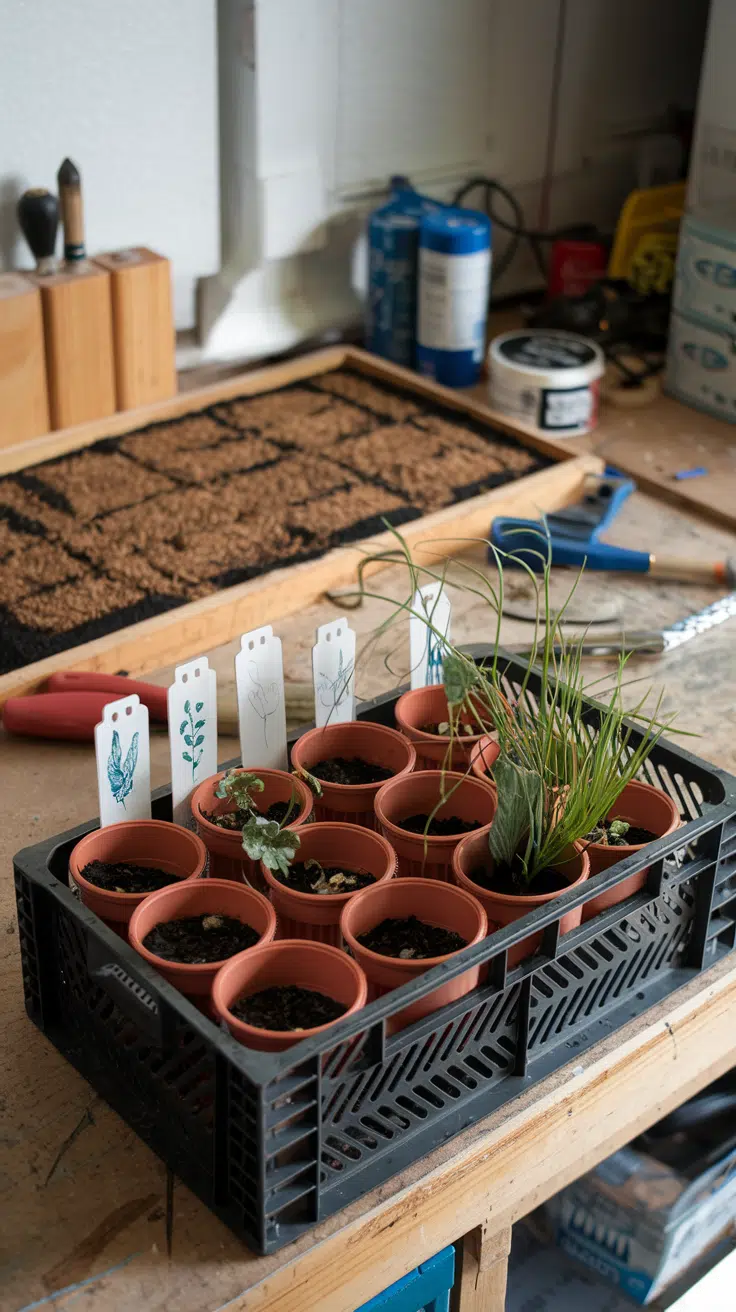
Sustainable window boxes start with smart material choices. Skip the plastic liners. Forget peat moss. Build systems that improve with age.
Coconut coir liners from retired doormats work brilliantly. Cut to fit your box. Natural fibers hold moisture. They biodegrade slowly—lasting two seasons. When they’re done, compost them. Free materials that perform better than store-bought.
Make compostable plant labels from yogurt containers. Cut strips. Write with permanent marker. Add QR codes linking to care instructions. Scan with your phone for instant plant info. When seasons change, toss labels in compost.
Drainage needs rethinking. Broken terra cotta pots create perfect drainage layers. Wine corks cut lengthwise work too. Old pantyhose filled with perlite make drainage socks. All reusable. All free from waste streams.
The modular insert system changes everything:
Start with 4-inch square pots. They fit perfectly in grid patterns. Any rectangular box accommodates them evenly. Create your grid from corrugated plastic—election signs work perfectly.
Cut dividers to create squares. Each plant gets its own removable pot. Sick plant? Pull one pot. Want to rearrange? Simple. Season change? Swap entire sections.
Benefits multiply: roots don’t tangle. Soil stays healthier. Aggressive spreaders can’t take over. You control each micro-environment. Plus transplanting causes zero shock.
Template measurements for common box sizes:
- 24-inch box: 6 pots across
- 30-inch box: 7-8 pots depending on width
- 36-inch box: 9 pots comfortably
Recycled materials for structure: Old venetian blinds make excellent plant supports. Bent into hoops or cut for stakes. Bicycle spokes create nearly invisible supports. Broken bamboo rakes provide natural-looking stakes.
Water conservation built in: Wine bottles with small holes become slow-release irrigators. Old sponges at pot bottoms retain moisture. Mulch from shredded newspaper reduces evaporation.
Every element serves multiple purposes. Nothing goes to landfills. And your boxes actually work better than conventional setups.
Creating Wildlife Micro-Habitats
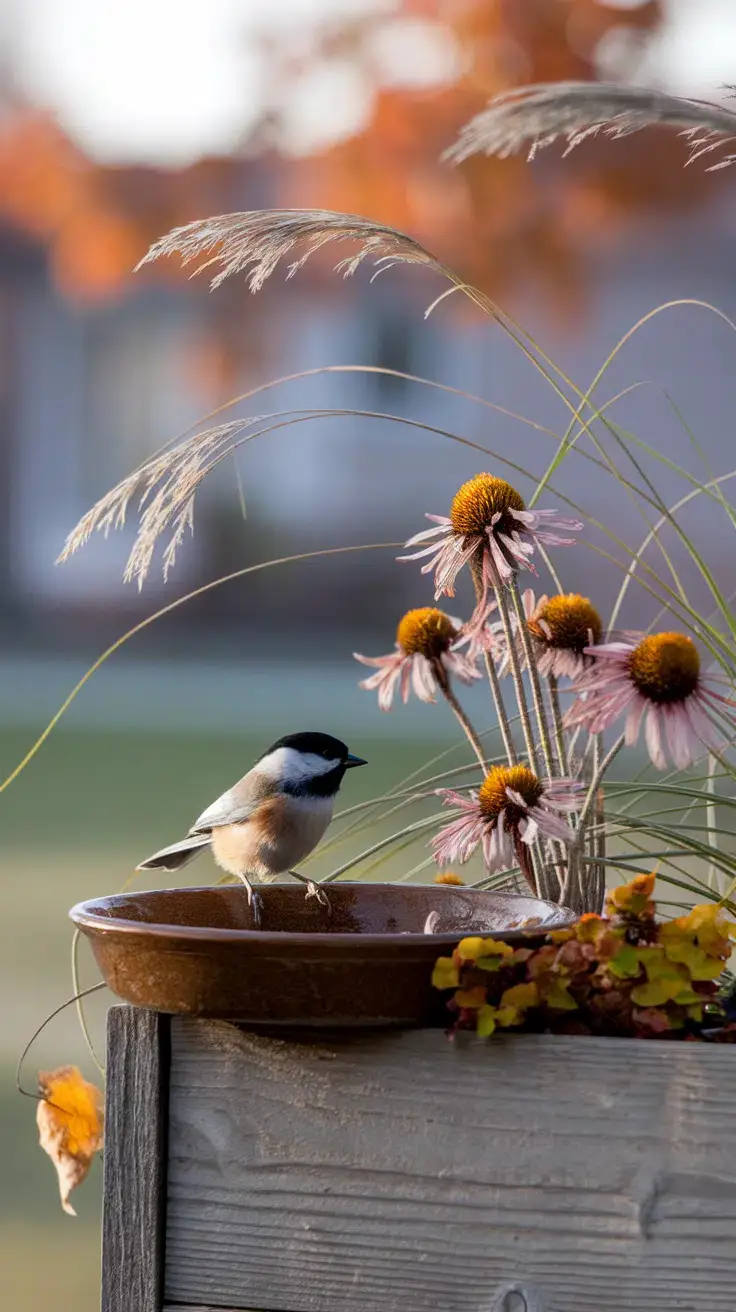
Your window box can be a migration rest stop. Birds need fuel and water during fall journeys. You provide both in mere square feet.
Mini birdbaths change everything. A ceramic saucer works. So does a large shell. Even a plant pot saucer. Keep it shallow—one inch maximum. Birds need secure footing. Change water daily. Add pebbles for perching spots.
Position baths near sturdy plants. Birds want escape routes. They’ll drink, bathe quickly, then hide in foliage. Watch from inside—window entertainment beats television.
Seed heads become natural feeders. Leave them standing through winter. Echinacea seeds feed goldfinches. Rudbeckia attracts chickadees. Ornamental grass seeds sustain sparrows. Sedum ‘Autumn Joy’ feeds multiple species.
But plan placement carefully. Seed heads near glass cause bird strikes. Keep them box-center or far edges. Dense plants below provide crash protection if needed.
Late-season photography opportunities multiply. Frost-covered seed heads. Birds silhouetted against winter sky. Morning light through grass plumes. Keep your camera ready—moments happen fast.
Balance wildlife needs with looks. Not every plant needs seed heads. Mix tidy plants with wild ones. Prune some, leave others. Your box can be beautiful and beneficial.
Pest management gets tricky with wildlife. No chemicals—obviously. But aphids and whiteflies still appear. Solution? More birds. They’re natural pest control. Chickadees eat thousands of insects daily.
Physical barriers work too. Fine mesh over young plants. Copper tape for slugs. Hand-picking when necessary. Accept some damage—perfect plants aren’t the goal.
Create layers for different visitors. Tall grasses for perching. Dense foliage for shelter. Open areas for ground-feeding birds. Varied heights attract varied species.
Your micro-habitat helps more than birds. Beneficial insects overwinter in hollow stems. Leave some standing. Native bees use bare soil patches. Don’t mulch everything. Butterflies need late nectar—keep some flowers blooming.
Small space. Big impact. Every window box helps.
Scent Through the Seasons
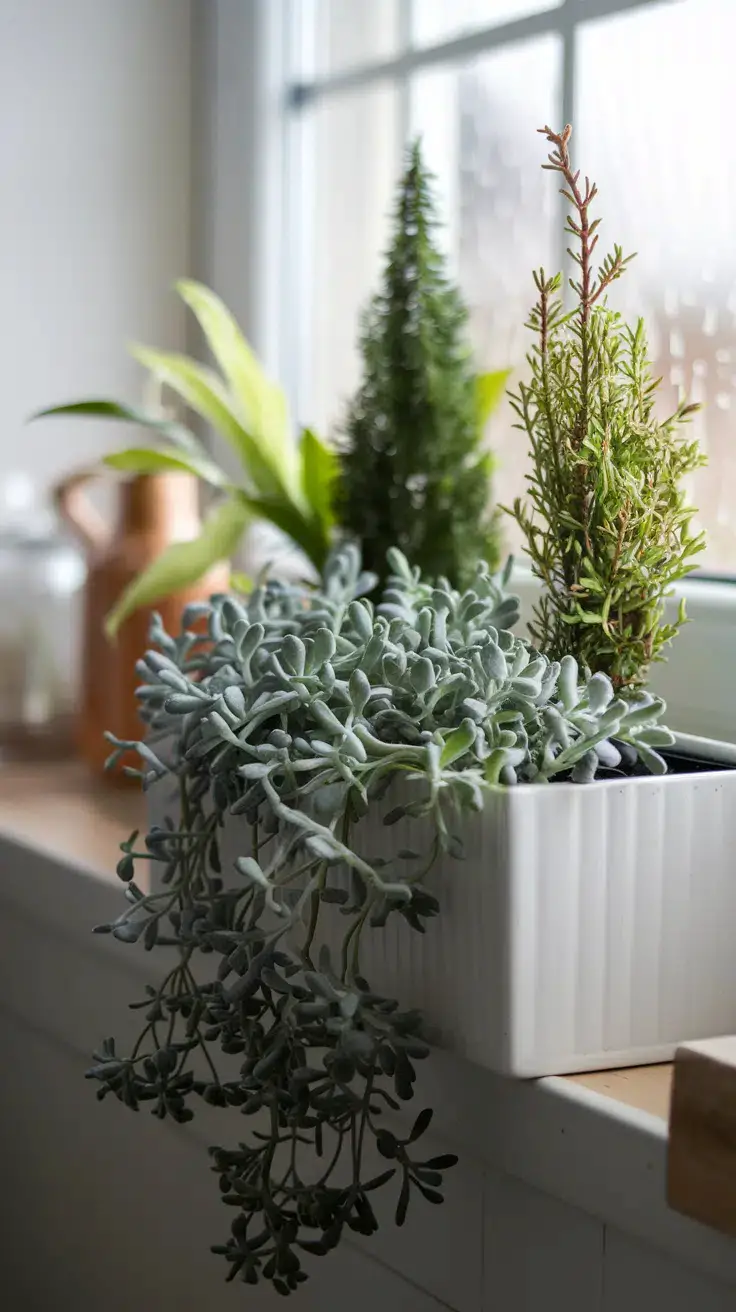
Scent might be the most overlooked element in window boxes. Yet smell triggers memory stronger than sight. Your nose knows seasons changed before your eyes do.
Plan fragrance rotation like flower succession. Different plants peak at different times. Cool weather intensifies many scents. Position matters too—place aromatics where air movement releases oils.
Early fall stars: Dwarf curry plant (Helichrysum italicum) smells like autumn itself. Not edible curry—more complex. Sage-like but sweeter. Silver foliage glows against fall colors. Brush it passing by. Instant aromatherapy.
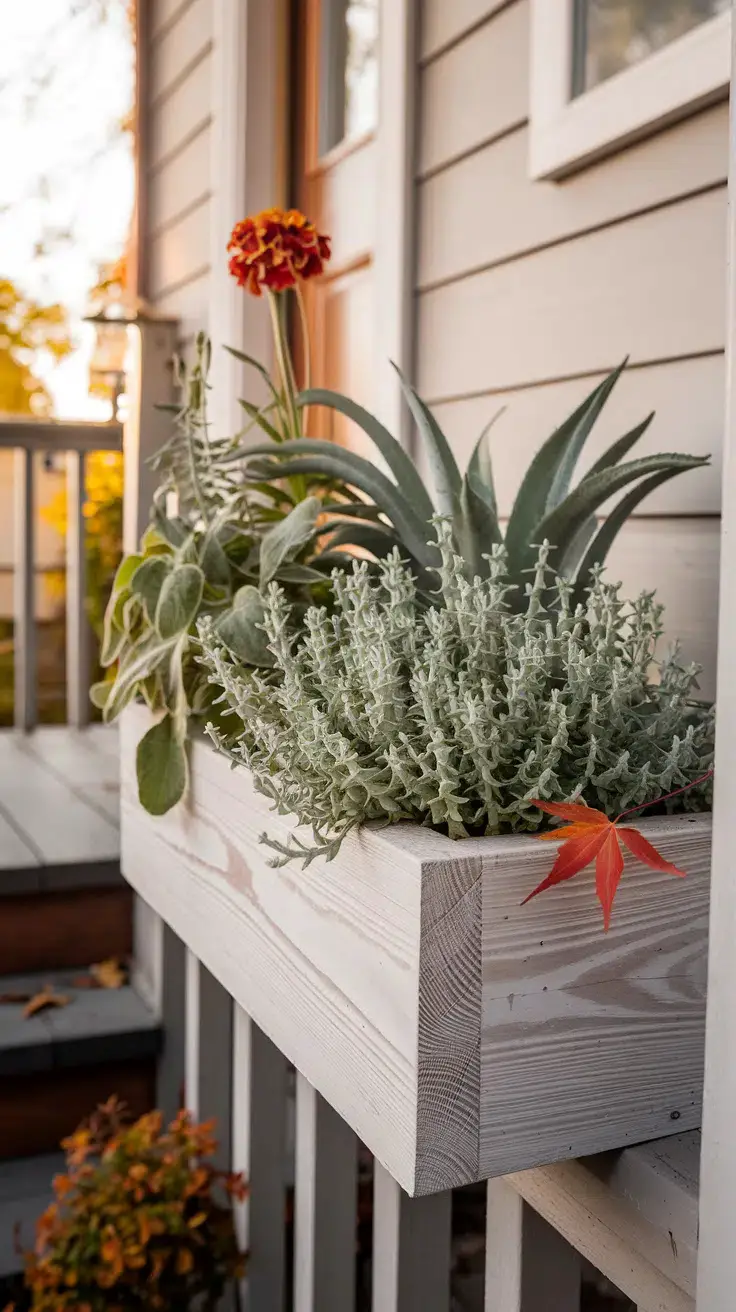
‘Nanum’ stays under 12 inches. Perfect for corners where you’ll brush against it. Hardy to zone 7. Mulch heavily in colder areas. Or grow as annual—worth replanting yearly.
Mid-fall through winter: Miniature lemon cypress fills cool air with citrus. Not subtle—genuinely lemony. ‘Goldcrest’ variety stays compact. Bright chartreuse adds color when flowers fade.
Needs protection from harsh wind. Place centrally, surrounded by tougher plants. Mist occasionally—releases more fragrance. Bring indoors before temperatures hit 20°F.

Late fall into spring: Sarcococca hookeriana humilis blooms when nothing else dares. Tiny white flowers pack vanilla-honey punch. Glossy evergreen leaves look good year-round. Spreads slowly by suckers.
Incredibly tough once established. Shade tolerant. Drought resistant. Deer proof. The perfect plant except for one thing—hard to find. Worth hunting for at specialty nurseries.
Placement strategies maximize scent impact. Under windows catches rising fragrance. Near doors greets you coming and going. Corner positions release scent from two directions.
Height matters. Tall plants throw scent farther. Low plants need close encounters. Mix heights for layered fragrance experiences.
Combine carefully. Some scents clash—rosemary fights with lavender. Others complement—lemon plus mint equals fresh. Test combinations with cut stems before planting.
Morning releases different scents than evening. Curry plant peaks midday. Sarcococca strongest at dawn and dusk. Plan viewing times around peak fragrance.
Don’t overwhelm. One strongly scented plant per small box. Two for larger containers. Let each have its moment. Your nose fatigues quickly—subtlety wins.
Plant Profiles with Stories
Generic plant descriptions bore everyone. These plants have stories worth telling.
‘Crane Red’ kale started with a Tennessee high school student. Josh Crane noticed unusual seedlings in his FFA project. Deep purple stems. Feathered leaves more intricate than normal kale. He saved seeds, selected best plants, stabilized traits over three years.
Now ‘Crane Red’ grows in window boxes nationwide. Leaves intensify color as temperatures drop. Burgundy becomes deep purple-black after frost. Edible but almost too pretty. Lasts through January in protected spots.
Local grower Sarah Martinez tells me: “Kids always pick ‘Crane Red’ at market. Those feathered leaves look like dinosaur food. Parents buy it for window boxes. Everyone wins.”
Short-season ranunculus revolutionized fall planting. Traditional varieties need long cool periods. New hybrids bloom in 60 days from corm planting. ‘Amandine’ series leads the pack.
Economics made this happen. Cut flower farmers needed fall crops. Breeders responded. Now home gardeners benefit. Plant corms in September. Blooms by November. Under $2 per corm beats $8 grocery store bunches.
Performance varies by region. Zone 7 and warmer—they’ll bloom through winter. Colder zones—enjoy until hard freeze, then compost. Either way, two months of papery blooms justifies cost.
Other standouts earning window box space:
‘Redbor’ kale: Another student selection. Magenta stems support frilly purple leaves. Survives -10°F. Sweetens after frost. Minnesota grower Tom Chen grows nothing else: “Customers drive hours for ‘Redbor’. I can’t grow enough.”
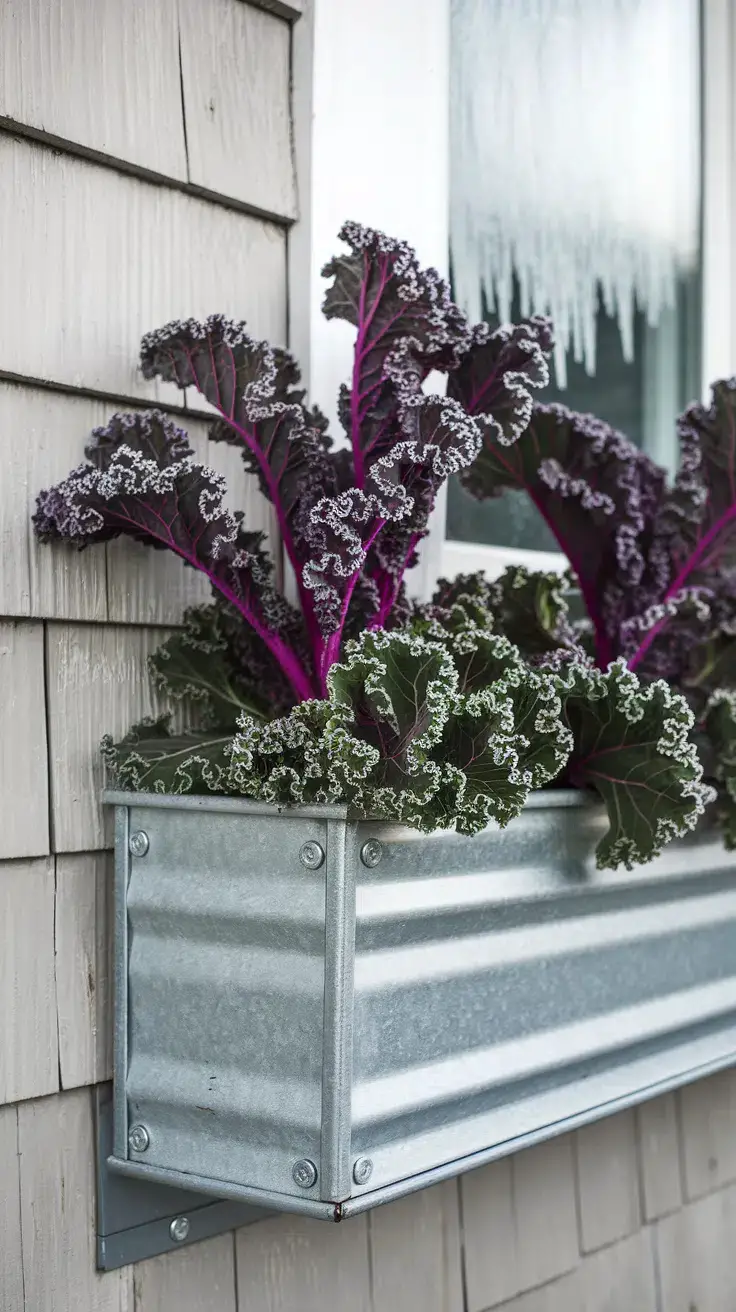
Cyclamen persicum ‘Silverleaf’: Hardy to 20°F. Silver-marked leaves outshine flowers. Blooms November through March. Disappears in summer—mark spots to avoid disturbance.
Helleborus ‘Winterbells’: Miniature hellebore for containers. Nodding white bells on 8-inch plants. Blooms December through March. Evergreen leaves add structure. Slow growing but worth patience.
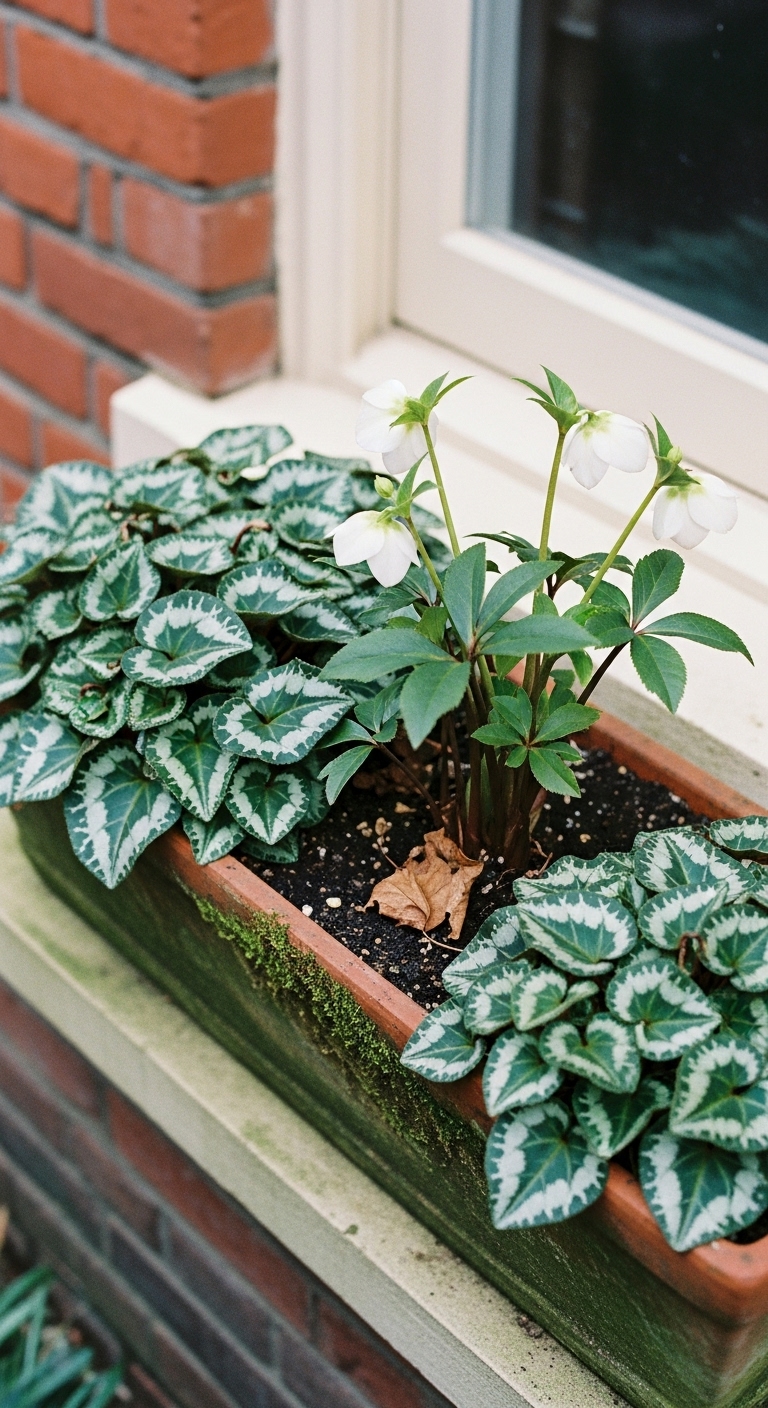
Real performance data from window box trials:
‘Crane Red’ kale: 89% survival rate through zone 6 winter
‘Amandine’ ranunculus: Average 12 blooms per corm
‘Silverleaf’ cyclamen: Bloomed 127 days continuously
‘Winterbells’ hellebore: Increased 40% in size yearly
These aren’t just plants. They’re achievements. Student discoveries. Breeding breakthroughs. Economic solutions. Every window box tells stories.
The Failure Reel: Learning from Mistakes
Picture this: A window box disaster showing crispy brown mums, toppled-over ornamental grasses, and slug-eaten pansies, with a frustrated gardener’s gloves and trowel abandoned on the windowsill. A “Week 1” photo tucked into the frame shows the same box looking perfect, highlighting the dramatic decline. Style guide: Honest documentary shot, harsh midday light emphasizing the damage, slightly tilted angle suggesting chaos, unfiltered reality
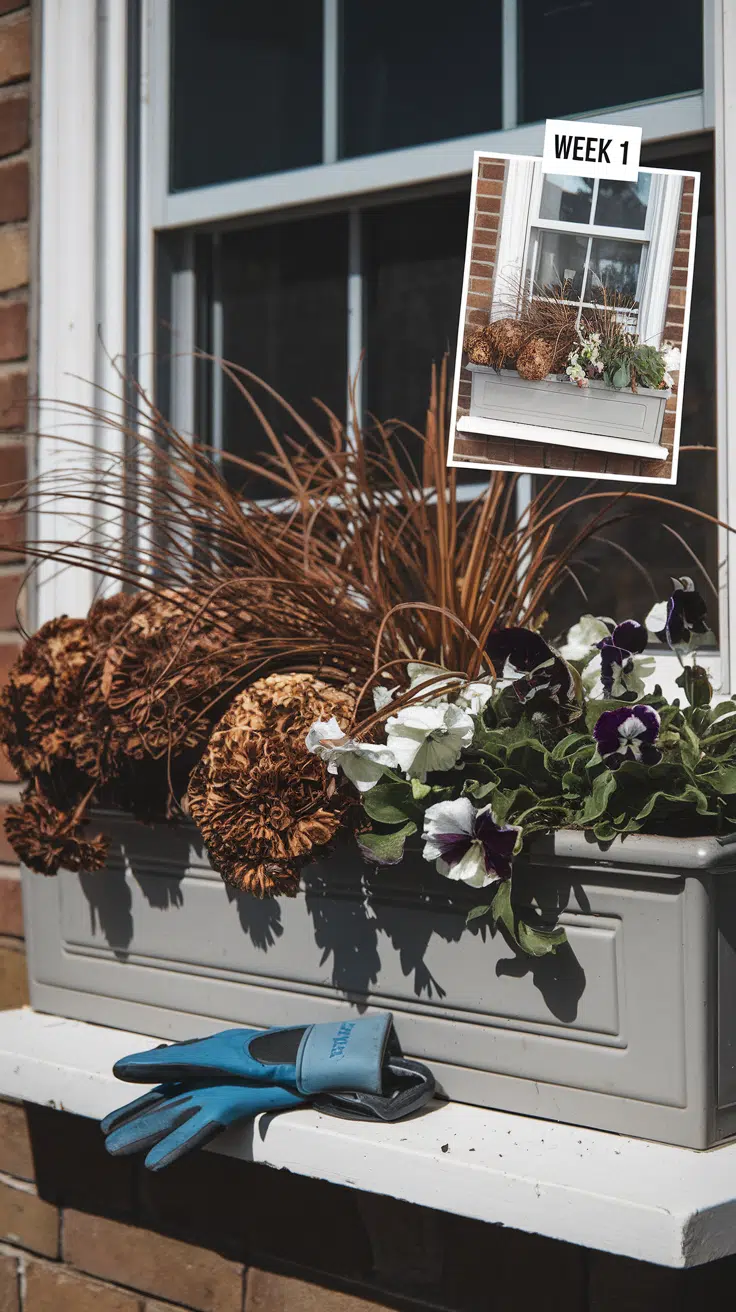
Let’s talk window box disasters. Mine specifically. Because failure teaches more than success ever could.
October 2019: Installed gorgeous succulent box. Mixed sedums, echeveria, jade plants. Looked like a magazine cover. For exactly one week. Then temperatures plummeted to 25°F. No warning. No protection. Everything turned to mush.
Lesson learned: Check hardiness zones. Actually check them. “Succulent” doesn’t mean cold-hardy. Zone 9 plants don’t survive Zone 6 winters. Obviously. Expensive obviously.
November 2020: Designed elaborate herb window box. Rosemary, thyme, sage, oregano. Mediterranean paradise. Except my window faced north. With reflected shade from neighboring building. Herbs stretched desperately toward nonexistent sun. Developed powdery mildew. Died slowly, painfully.
Lesson learned: Sun-loving plants need actual sun. Not hopeful thinking. Not “maybe enough” light. Real, measured, documented sunlight hours.
September 2021: Created stunning grass display. Purple fountain grass, Japanese forest grass, blue fescue. Movement and texture! Until first windstorm. Tall grasses acted like sails. Entire box crashed onto sidewalk. Soil everywhere. Plants destroyed. Neighbors amused.
Lesson learned: Physics matters. Tall plants need heavy boxes. Or serious anchoring. Wind load calculations aren’t just for engineers.
This year’s disaster? Overwatering automation. Installed drip irrigation. Set timer. Went on vacation. Returned to swamp conditions. Root rot everywhere. Fungus gnats having parties.
Week 1 photos always look perfect. Week 8 tells truth. Document both. Share failures. Everyone kills plants. Experts just kill them more creatively.
Turn failures into next season’s wins. Those dead succulents? Replaced with hardy hens-and-chicks. Failed herbs? Now growing shade-tolerant coral bells. Crashed grass box? Rebuilt lower, wider, heavier.
Keep failure notes. Date problems appeared. Weather conditions. What you tried. What worked (if anything). Reference next year. Memory lies. Notes don’t.
Your Personalized Action Plan
Picture this: A kitchen table spread with graph paper, plant catalogs, seed packets, and a laptop showing weather data. A window box sits nearby with temporary plant arrangements being tested. Coffee stains and eraser shavings show real planning in action, not staged perfection. Style guide: Overhead flat lay, natural window light, lived-in feel with authentic mess, documentary style
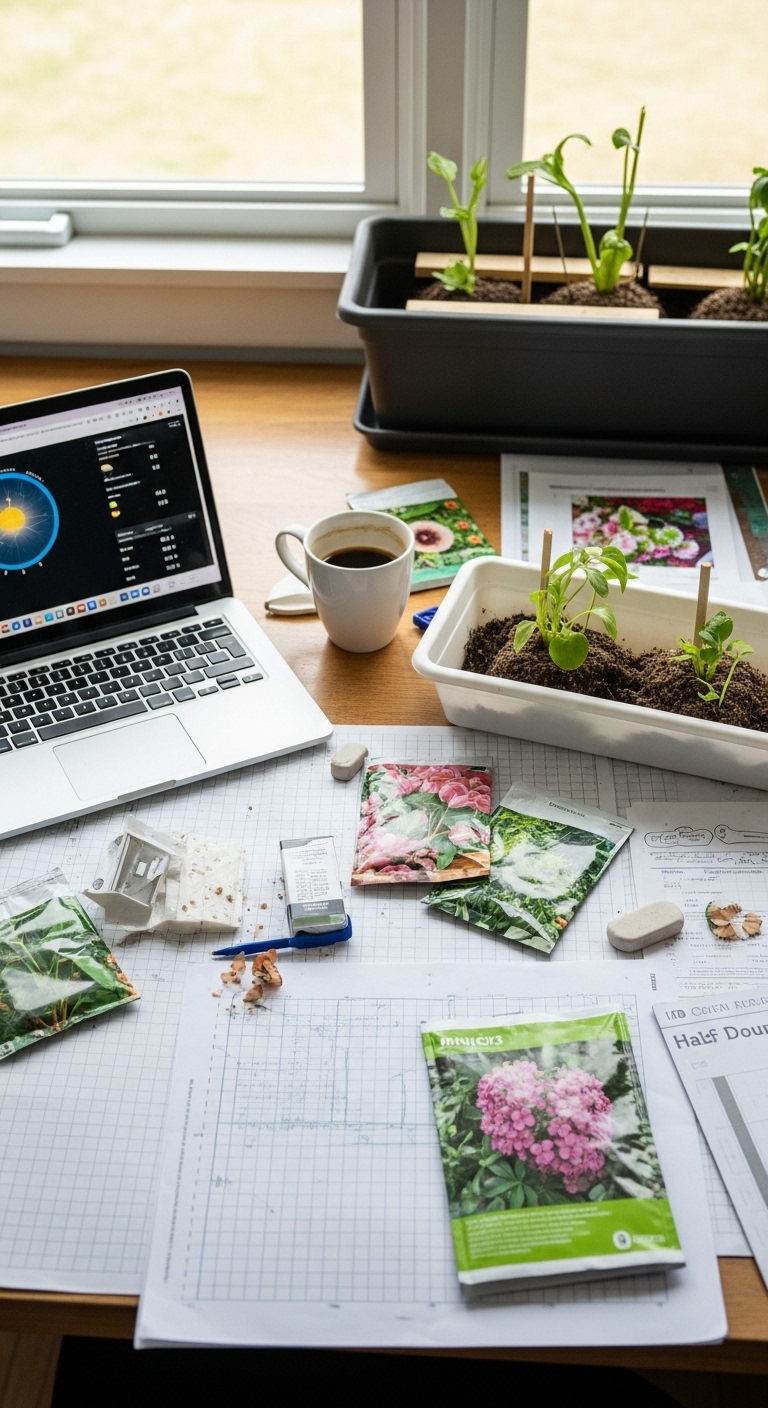
Stop reading. Start doing. Here’s your decision flowchart:
Temperature drops below 25°F?
If yes: Focus on kale, ornamental cabbage, evergreens
If no: Add pansies, cyclamen, primrose
Wind exposure high?
If yes: Low, mounding plants. Heavy containers. Extra anchoring
If no: Include taller elements. Ornamental grasses. Trailing plants
Pest problems common?
If yes: Include aromatic herbs. Use copper barriers. Plan for hand-picking
If no: Wider plant palette. Include tender beauties
Budget under $50?
If yes: Start seeds. Divide existing perennials. Shop end-of-season sales
If no: Invest in statement plants. Quality containers. Automated watering
Specialized supply sources:
Unusual seeds: Johnny’s Selected Seeds for cold-hardy varieties
Miniature bulbs: Brent and Becky’s Bulbs for container-sized options
Copper tape: Garden supply stores or online for 2-inch width
Coir liners: Repurpose old doormats or buy bulk online
Modular inserts: Greenhouse supply companies sell propagation trays
Seasonal transition timeline:
September: Assess current plantings. Order special varieties. Start cool-season seeds
Early October: Remove tired summer plants. Refresh soil. Install structural elements
Mid-October: Plant main displays. Add bulbs for spring. Install lighting
November: Protect tender plants. Adjust watering. Add winter interest branches
December-February: Minimal maintenance. Document what works. Plan next year
March: Transition begins. Remove winter damage. Watch for bulb emergence
Adapt these ideas everywhere. Apartment balcony? Use same principles in railing planters. Large garden? Create window box “moments” throughout. Front door containers? Window box techniques scale up beautifully.
Common challenges solved:
“Everything freezes”: Double-pot with insulation between. Bubble wrap works
“Squirrels dig constantly”: Hardware cloth just below soil surface
“Nothing grows in deep shade”: Mirror or white paint on back wall reflects light
“Renters can’t attach boxes”: Heavy brackets hook over sills. No drilling
Start small. One perfect window box beats five mediocre attempts. Learn what works. Expand next season.
Over to You: Your Window, Your Canvas
Window boxes aren’t just containers. They’re personal expressions. Daily connections to nature. Miniature worlds you control completely.
We’ve moved beyond tired mums-and-pumpkins displays. You understand micro-climates now. Texture matters more than flowers. Scent adds invisible beauty. Wildlife brings life. Sustainable methods save money and planets.
Your window box can feed you. Glow after dark. Tell stories. Support migrations. Survive winter. Even teach through failure.
Experiment freely. Break rules confidently. Share successes and disasters equally. Use #BeyondMumsAndPumpkins to connect with other window box revolutionaries.
That rectangle outside your window? It’s not decoration. It’s possibility. Living art that changes with seasons, weather, and whim.
Your window. Your rules. Your masterpiece.
Now go make something extraordinary.
